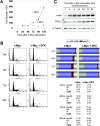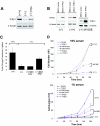Activation of transferrin receptor 1 by c-Myc enhances cellular proliferation and tumorigenesis
- PMID: 16508012
- PMCID: PMC1430295
- DOI: 10.1128/MCB.26.6.2373-2386.2006
Activation of transferrin receptor 1 by c-Myc enhances cellular proliferation and tumorigenesis
Abstract
Overexpression of transferrin receptor 1 (TFRC1), a major mediator of iron uptake in mammalian cells, is a common feature of human malignancies. Therapeutic strategies designed to interfere with tumor iron metabolism have targeted TFRC1. The c-Myc oncogenic transcription factor stimulates proliferation and growth by activating thousands of target genes. Here we demonstrate that TFRC1 is a critical downstream target of c-Myc. Using in vitro and in vivo models of B-cell lymphoma, we show that TFRC1 expression is activated by c-Myc. Chromatin immunoprecipitation experiments reveal that c-Myc directly binds a conserved region of TFRC1. In light of these findings, we sought to determine whether TFRC1 is required for c-Myc-mediated cellular proliferation and cell size control. TFRC1 inhibition decreases cellular proliferation and results in G1 arrest without affecting cell size. Consistent with these findings, expression profiling reveals that TFRC1 depletion alters expression of genes that regulate the cell cycle. Furthermore, enforced TFRC1 expression confers a growth advantage to cells and significantly enhances the rate of c-Myc-mediated tumor formation in vivo. These findings provide a molecular basis for increased TFRC1 expression in human tumors, illuminate the role of TFRC1 in the c-Myc target gene network, and support strategies that target TFRC1 for cancer therapy.
Figures






References
-
- Adhikary, S., and M. Eilers. 2005. Transcriptional regulation and transformation by Myc proteins. Nat. Rev. Mol. Cell. Biol. 6:635-645. - PubMed
-
- Alizadeh, A. A., M. B. Eisen, R. E. Davis, C. Ma, I. S. Lossos, A. Rosenwald, J. C. Boldrick, H. Sabet, T. Tran, X. Yu, J. I. Powell, L. Yang, G. E. Marti, T. Moore, J. Hudson, Jr., L. Lu, D. B. Lewis, R. Tibshirani, G. Sherlock, W. C. Chan, T. C. Greiner, D. D. Weisenburger, J. O. Armitage, R. Warnke, R. Levy, W. Wilson, M. R. Grever, J. C. Byrd, D. Botstein, P. O. Brown, and L. M. Staudt. 2000. Distinct types of diffuse large B-cell lymphoma identified by gene expression profiling. Nature 403:503-511. - PubMed
-
- Becton, D. L., and P. Bryles. 1988. Deferoxamine inhibition of human neuroblastoma viability and proliferation. Cancer Res. 48:7189-7192. - PubMed
-
- Blatt, J., and S. Stitely. 1987. Antineuroblastoma activity of desferoxamine in human cell lines. Cancer Res. 47:1749-1750. - PubMed
-
- Bowen, H., T. E. Biggs, S. T. Baker, E. Phillips, V. H. Perry, D. A. Mann, and C. H. Barton. 2002. c-Myc represses the murine Nramp1 promoter. Biochem. Soc. Trans. 30:774-777. - PubMed
Publication types
MeSH terms
Substances
Grants and funding
LinkOut - more resources
Full Text Sources
